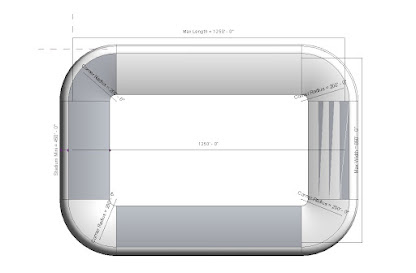Allianz Arena by Peyton Roberts
Parametric Modeling Process - Allianz Arena
Peyton Roberts
-----------------------------------------------------------------------------------------------------------------------------
Step 01 - Design Intent
My design intent is to create a parametric model of the Allianz Stadium to be able to adapt to varying parameters and constraints. The goal of my design intent is to be able to test the set parameters to see if the stadium adjusts accordingly.
Step 02 - Creating the Stadium Footprint Parametrics
I created a preliminary sketch of the stadium based on the floor plans found. Once the main components of the stadium were outlined, I began to add parameters to the lines, ensuring the length and the width were controlled by the driving parameter; the corner radius.
Prior to moving on to the next step, the types were tested to ensure there were no conflicts.
Step 03 - Creating the Section Profile
Once the stadium footprint was parametrically created, the next step was to create the outline of the section. Importing the section reference image into Revit allowed for the general outline of the facade shaping, and the seating angles were created.
The section was then aligned with the stadium's footprint outline. Individual segments of the shapes were then selected and I used the 'create form' button to create the stadium sweep.
Step 04 - Create Form
Once the stadium's form was created, the individual segments were selected, and the 'divide surface' tool was used to create a grid along the exterior segments. Each input was tested to ensure the parameters were working efficiently.
After the form was created, a parametric curtain panel was created to import into the mass family file.
Step 05 - Parametric Curtain Panel
A new parametric family was created to apply to the grid (divide surface) of the stadium sweep. The parametric curtain panel created a center point with a height of 12" with the surface of the panel curving down to the four corner points.
The parametric family was then imported into the massing family and placed on each of the segments of the stadium. Parameters were then tested to ensure no conflicts arose with the combination of the mass and panel families.
Step 06 - BIM Modeling
Once the massing family was completed, with the parametric panels placed on the grid, the family was saved and imported into a project file. The stadium sweep was selected and the 'model floor' button was used. Each individual panel is then needed to be selected to use the 'wall by face' component to create the panel surface.
Exterior Render
Interior Render
Step 07 - Testing Parameters
Throughout all steps and phases of the project, the type parameters were tested to ensure the massing parameters were flexing properly with new inputs and no errors arose.
Limitations of Revit
During the process of creating the massing family, the parametric family, and the project file, I ran into issues several times that made me adjust accordingly.
The main issue that arose was in applying my parametric curtain panel onto the massing family. For unknown reasons, my parametric panel family would deform into unique shapes depending on the segment I applied it to. It would have perforations (gaps) within the panels regardless of the gridline sizing and re-adjusting of the panel family itself. Eventually, a new family was created and finally worked, but it remains a mystery to me as to why the initial panel family was not working correctly.
Generative AI
Generative AI Image 01
Prompt: Allianz Stadium, varying facade shapes
Generative AI Image 02
Prompt: Allianz Stadium, varying facade shapes, organic panels
Prompt: Allianz Stadium, varying facade shapes, organic panels, sharp edge variations














Comments
Post a Comment